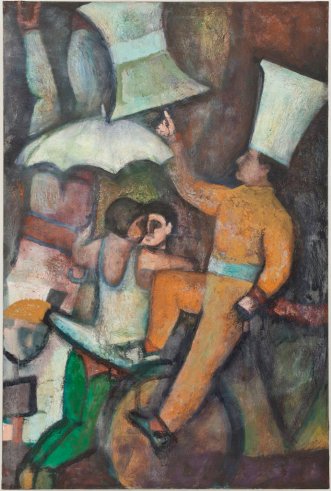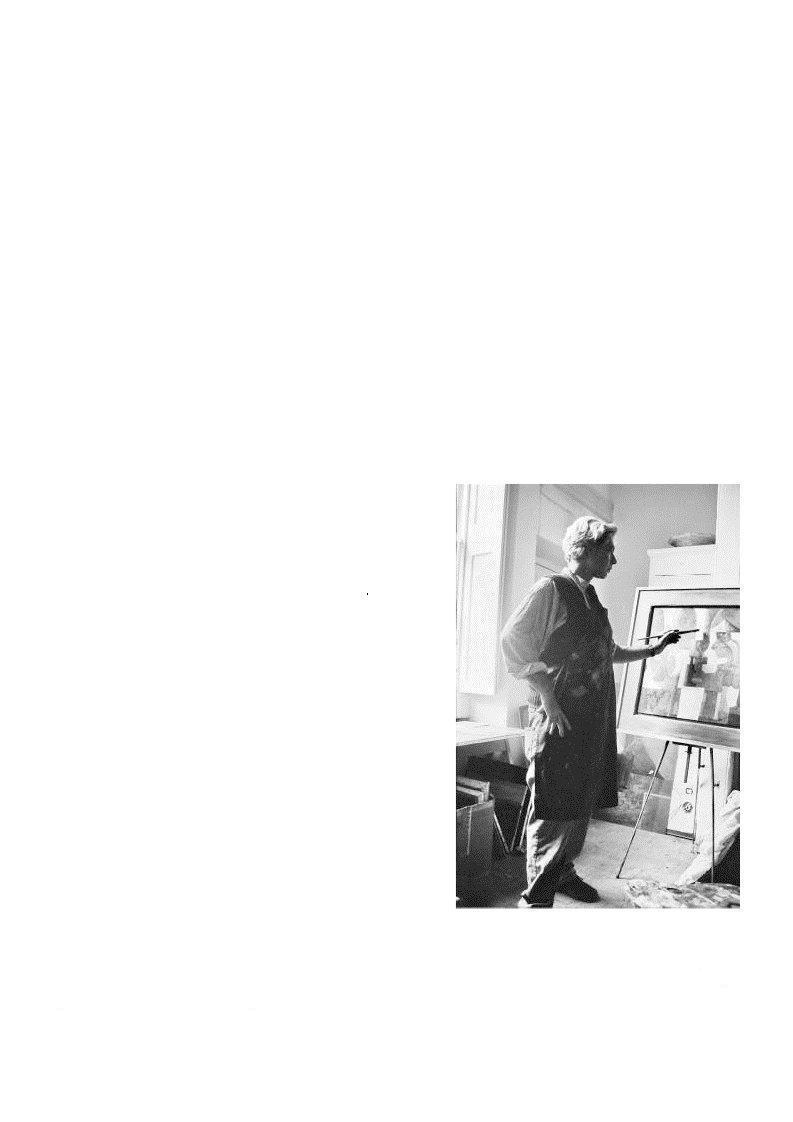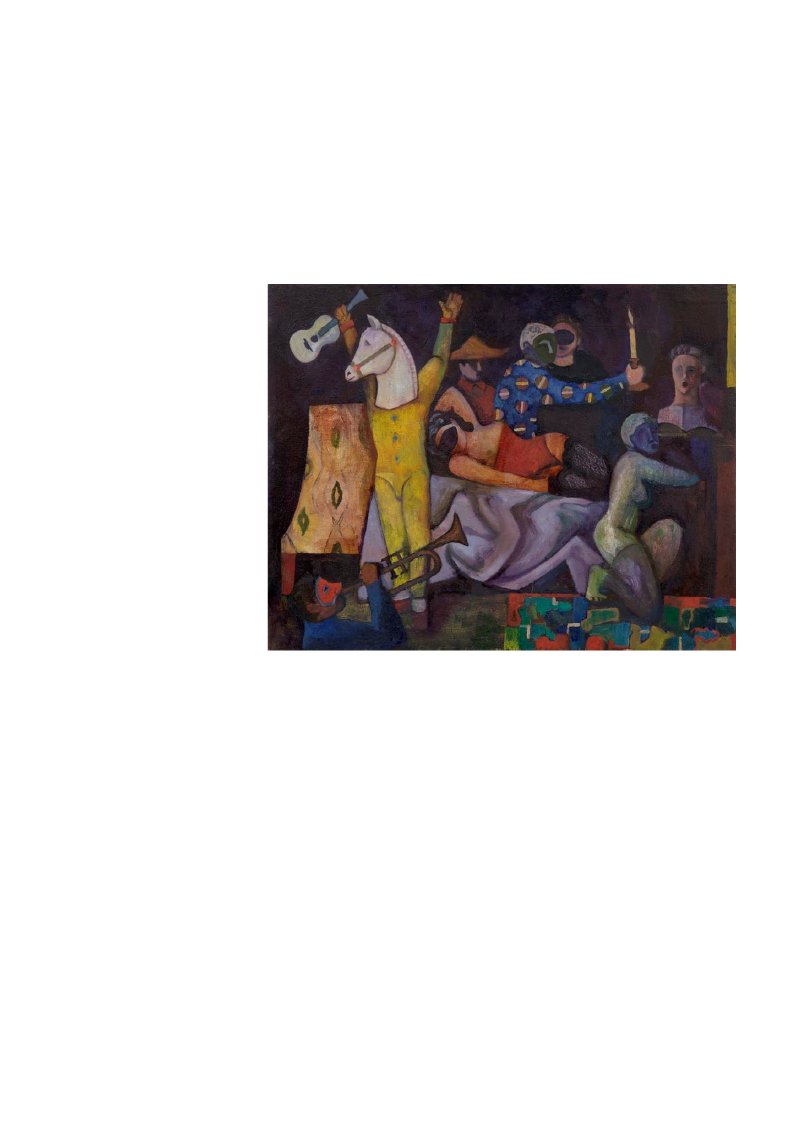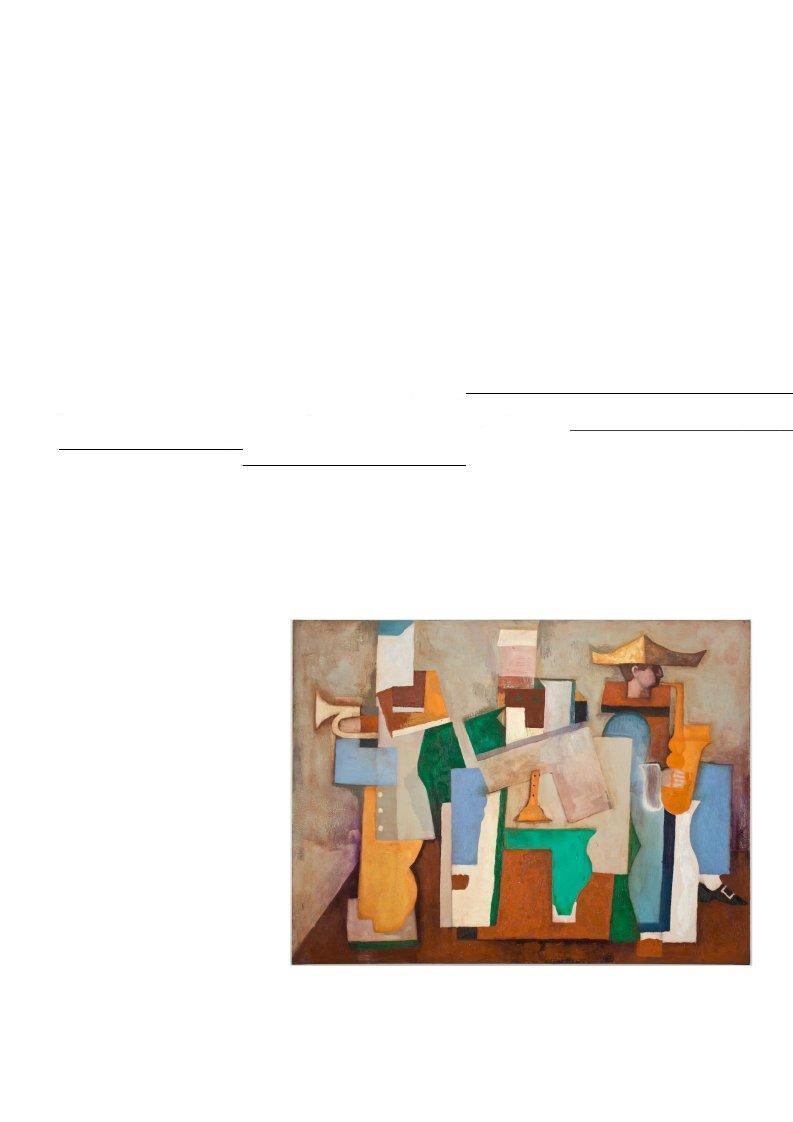
Media Release
-For Immediate Distribution-
UPCOMING EXHIBITION OF NEW WORKS BY
W I L LI A M BA L T H A Z A R R OSE
S&D GALLERY
15 Thackeray Street, Kensington
For more information:
Wende Elliott Barbara Djebali, S&D Gallery 15 Thackeray St.
0754-3816 976 Kensington, London W8 5ET 0044-2079377020
wende.elliott@yahoo.co.uk barbara.djebali@sdgallery.co.uk
“Rose has in fact achieved something far more
impressive than the Hirsts and Emins by
demonstrating that something genuinely new can
still be created within the traditional idiom of
picture-making.” - Prof. Edward Chaney
“It is in this gap and the strange, almost impossible,
conversation between Piero della Francesca and
Franz Kafka that the work of William Rose
resonates.” -Prof. Sean Gaston
“At times Rose conjures late Sickert, Beckmann,
Balthus, Morandi, Manet, and Cezanne, variously
inimitable and idiosyncratic painters who provide
an oblique benchmark for Rose’s inherent
individualism and privileged position on a post-
modern pluralist parapet.” -Peter Davies
Twenty new works by William Balthazar Rose
will be exhibited at the seductively chic S& D
Gallery newly opened by Barbara Djebali. The
exhibition is entitled ‘The Painter-Cook and
Friends’ and begins September 10th at 15
Thackeray Street, Kensington, W8 5E T.
Balancing Act 2013
Raised in a family of painters and intellectuals, William Balthazar Rose was born in 1961 in Cambridge.
He studied in the USA, at the University of California and Princeton where he graduated in Art and in
Architecture successively. He gave up a lucrative career as an architect to follow a more poetic journey as
a painter, dividing his time between studios in England and Italy.
Rose’s work is collected by such celebrities as Michel Roux, Jr. and American artist Wayne Thiebaud,
and has been appreciated greatly by public and critics alike. His painting is hermetic, the forms are simple
and indefinite; notable is the influence he has received from artists such as Piero della Francesca, Ottone
Rosai and Giorgio Morandi in painting, and Federico Fellini and Pier Paolo Pasolini in cinema.

Excerpts:
Critical Responses to the Art of William Balthazar Rose
Excerpt from ‘Tradition and Individual Talent’ by Edward Chaney
“Rose . . . has forged his own style which is now as recognizable as the style of any great master. What
might at first strike one as a mannerism becomes something one cannot quite imagine being any other
way. Even the hats, quasi-comical but quasi-pharaonic or Chinese or Balthusian have an inevitability
about them. A melancholy that is not, however, depressing pervades the whole surface of the canvas or
board. Timeless questions hanging in the air; something is about to be enacted but never quite carried out.
The figures and faces have interesting surfaces but are depicted without much detail, leaving the viewer
to fill in the missing visual and thus conceptual account… In many of the pictures some sort of
interrogation is going on, reminding one of Kafka’s notion that we are always ‘before the law’ ('vor dem
Gestez’).”
“For it is indeed among these artists and those successors
who worked into the middle of the twentieth century that
one finds the most relevant context in which to discuss the
work of William Rose, whose his artistic forebears include
not merely the internationally-recognized Giorgio de
Chirico, Carra and Morandi but the slightly later and less
widely known Felice Casorati, Mario Sironi, Ottone Rosai
and Massimo Campigli.1 These last provided some of the
ingredients that Rose has absorbed whilst developing his
own very distinctive style, a style that has thus evolved
outside the safer area of his native aesthetic environment.
This makes him something of an acquired taste where
Anglo-Saxony is concerned.”
“Hirst’s recent attempts to lend his oeuvre an air of ancient
authority (as in his diamond skull or golden calf) fails to
rival the integrity evident in any part of one of Rose’s
pictures. The quality of his paint surfaces makes Rose one
of those artists of whom it really can be said that it is
essential to see the pictures themselves rather than any form
of reproduction. . . Rego proceeds along the more vivid,
narrative style suggested by Balthus, Rose seems to have
followed the more meditative path.”
Edward Chaney is Professor of Fine and Decorative Arts at Southampton Solent University. He has
published A Traveller’s Companion to Florence, The Evolution of the Grand Tour, The Evolution of
English Collecting, Richard Eurich: 1903-1992: Visionary Artist and Inigo Jones’s ‘Roman Sketchbook’.

Excerpt from ‘The Mysterious Iconography of William Balthazar Rose’ by Peter
Davies
“Rose is a knowing and self-critical artist, widely travelled and well informed. His subject-matter is familiar yet
disarmingly elusive and enigmatic”
“Typically the paint is lush, the colour rich and multivarious and the forms robust—not unlike Brangwyn and
Sickert from the past or Stephen Conroy, Bill Jacklin and Chris LeBrun from the present. The forms become
ciphers for stylistic paraphrase or experiment—groups of musicians, cooks or street congregations flattened into
compounded cubist silhouettes or subverted into disquieting de Chiricoesque juxtapositions.”
“Utilising familiar and everyday
material Rose presents
mysterious scenarios that,
courtesy of an almost fortuitous
post-modern pluralist mix, touch
on surrealism, metaphysical
painting, realism, and
symbolism. The pictures do not
buy into the ephemeral mini-
trends of post-pop, post-feminist,
new image work but rather draw
inspiration from the past in order
to make sense of the present.”
“At times Rose conjures late
Sickert, Beckmann, Balthus,
Morandi, Manet, and Cezanne,
variously inimitable and
idiosyncratic painters who
provide an oblique benchmark
for Rose’s inherent individualism
and privileged position on a post-
modern pluralist parapet.” Whose Dream is This?
Excerpt from “William Balthazar Rose” catalogue introduction, Brian Sinfield,
Gallery Director
“William Balthazar Rose’s vision culminates in work of remarkable creative power. His extraordinary symbolic
figurative paintings are not only striking at first encounter, but also deeply thought provoking. They have the
ability to disturb, and at the same time, to make one smile.”
Excerpts from William Rose: Images from Bath and Italy by Jon Bennington,
Curator of the Victoria A rt Gallery, Bath, England
“He reserves his most passionate admiration for painters of the past such as Piero della Francesca,
Chardin, Corot, Cézanne and Morandi. He has even followed the Piero trail to the extent of settling in the
town of the artist’s birth, Sansepolcro, thereby subjecting himself to many of the same sensory stimuli as
the Renaissance master…”

“Merely describing the painter’s methodology, however, will not enlighten the viewer as to the meaning
of these works. What are they about? We will all take away something different, and that is only right
and proper, but the lasting impression for me is one of a serene and fragile arcadia, an earthly foretaste of
a better place. Human protagonists, when they appear, are subservient to this sense of a higher order –
apparent in their linear geometry –, albeit seasoned with a wry sense of humour.”
Excerpt from Transfigurazione e Tradizione by Sean Gaston
“It is in this gap and the strange, almost impossible, conversation between Piero della Francesca and Franz Kafka
that the work of William Rose resonates. . . . For Rose, the painter is a cook. He paints and dwells in the old
Platonic battlefield of the artist as artisan and as an imitator, a mimic of the truth. The painter cooks and mixes
artifice (technique, skill, technology, tekhne) with imitation (representation, illusion, confusion, mimesis) and
threatens nature (phusis) itself. He cooks and he is cooked: taken away from the very thing that he reaches for,
without rest. The painter as cook can never choose between Arcadia and Gregor Samsa, between transfiguration
and tradition.“
Dr Sean Gaston is author of numerous books including Starting with Derrida, Derrida and Disinterest,
Derrida, Literature and War, and Reading of Derrida’s of Grammatology. He is a member of Brunel
College, London, and has also written numerous essays amongst which Gregor Samsa in Arcadia: The
Paintings of William Rose features. The essay was published in Italian in the catalogue “Sinfonia di
Cappelli” under the title Transfigurazione e Tradizione (Transfiguration and Tradition).
Excerpts from L’Universo Gemino by Paolo Turcis:
“William Balthazar Rose’s painting is based on different artistic traditions, the result of an unlimited
figurative culture. From the genial cubist revolution to the lessons of the metaphysical, from the rarefied
atmospheres of Morandi’s still lives, to the harmonies of Renaissance art, the most intense artistic
experiences of the past centuries are revived in these paintings full of visual charm. An extraordinary
chromatic ability together with
refined technical skills make up
the artist’s highly remarkable
style. A sensitive man, Rose is
polyedric and eccentric, inclined
by nature to an intimate study of
reality, made up of pauses and
silence.”
“A thick haze obscures the
backgrounds of certain
disquieting paintings. From
darkness emerge cooks grasping
cleavers, and mysterious solitary
tennis players. What has occurred
in Rose’s paintings?”
“This poetic behavior expresses
ulterior meanings beyond the
animated chromatic backdrops. A
germinating, twin world emerges, speculative, but of inverted tones, similar to the negative of a
photograph. Enigmas one could say obscure prophecies that break up the idyllic woods…. the calm

equilibrium recalling the aulic indifference of Piero becomes a remote reference, visionary
transfiguration, and ironic quotation.”
Paolo Turcis and Sean Gaston wrote accompanying essays for the exhibition catalogue Sinfonia di
Cappelli published by Edizioni LaLoggia in 2007. Paolo Turcis, Serena Burroni, and Federica Tiripelli
in addition provided analysis of specific paintings. The essay L’Universo Gemino (the Twin Universe)
outlined aspects of Rose’s Italian work, and made an attempt to locate his work within the context of
contemporary society. Paolo Turcis is an expert on the work of Alberto Sughi, and has assisted Giovanni
Faccenda (director of the civic museum of modern and contemporary art in Arezzo) in the cataloguing of
Sughi’s work. Above are excerpts from the essay L’Universo Gemino.
Excerpt from catalogue introduction by Ugo Agostinelli, director of Galleria
LaLoggia:
“I saw a painting, possibly from the ottocenesca in a shop window. Suddenly I was taken with it and
asked about its author. I realized that it wasn’t a work of a painter from the past but of a contemporary, an
English cosmopolitan artist who lived in Sansepolcro and was completely unknown as a painter.”
Galleria LaLoggia in Sansepolcro, directed by Ugo Agostinelli, has been responsible for several
important exhibitions in central Italy. These include solo shows of Alberto Sughi, Adriano Alunni, Mimmo
Rotella and Laura Fiumi in addition to the grand twentieth century retrospective Da DeChirico a Ferroni
curated by Giovanni Faccenda.
Excerpt from “But What Are Those Chefs Cooking?” by Jonathan Saville
“It is a general truth that the artistic imagination is beyond explanation by causes and contexts.
Imagination is, in the deepest sense, the artist himself, his signature, his freedom. In this case, we are
confronted with an imagined world that is all the more bizarre because, at first, it seems merely a bit
enigmatic. It is only after you have looked at Rose’s paintings for a considerable while, without
distractions (for these pictures are uncannily silent, and the least outside noise can break their spell), that
there limitless strangeness reveals itself. . . No explanations are given: if the artist knows the answers, he
has taken care not to communicate his knowledge. . . . it is from the figure scenes that one gets the full
force of the ineffable mystery this artist can evoke. . . .
After a while, one begins to perceive a curious density lying not in the specific natural objects but in the
artist’s vision of them. The world Rose shows us is thick, dark, sculptural yet fluid, a kind of slowly
moving lava of being that has clotted into natural forms, but that seems capable of being stirred into
motion again, when it will gradually dissolve this scene and with its viscous eddies and upthrusts
compose another.”
“The reductive treatment of forms and surfaces in Rose’s pictures-- another example of this odd, dark,
geometrized world --is the exquisite Fete Trumpeter he calls Pastoral, is reminiscent of Piero della
Francesca, and so is the static quality, as though time and action were suspended forever. But the artists
these paintings remind me of most are from 18th century Venice: Pietro Longhi, with his peculiarly
mysterious genre scenes, and Domenico Tiepolo, whose strange pictures of white-costumed clowns in
their tall smoke-stack hats may have given inspiration to Rose for his own preoccupation with chefs, and
here is the oddest (and most delightful) fact of all about William Balthazar Rose: that an artist in this day
and age should ignore all current fashions and take as his model Venetian art of the 18th Century, and
make something so wonderful of it!”
Jonathan Saville wrote the review of the sellout exhibition at Thomas Babeor and Company Gallery in La
Jolla, California, where the entire collection of paintings was sold to the collection of Mason Phelps, a
director of the San Diego County Museum.
[Type text]